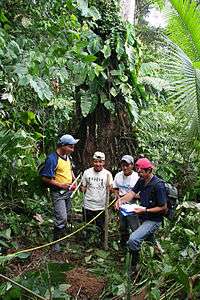Awa-Kwaiker people
 | |
| Total population | |
|---|---|
| 32,555[1] | |
| Regions with significant populations | |
| 3,000 (1987)[2] | |
| 6,000–8,000 (1987) | |
| Languages | |
| Awapit language[2] | |
The Awá (or Kwaiker) are an ancient indigenous people that inhabit the regions of northern Ecuador (provinces of Carchi and Sucumbios) and southern Colombia (particularly the departments of Nariño and Putumayo). Their entire population is around 32,555 members.[1] They speak a language called Awapit.
Reserve
The Awa Reserve was established in northwestern Ecuador in 1987. The reserve combines indigenous and forestry legislature, so that the Awa people could manage the forest and their own lands.[2] This reserve is in the Chocoanos Forest within the Tumbes-Chocó-Magdalena region, one of the most biodiverse places on the planet, however logging and mining interests are illegally active in the reserve.[1]
Substistence
The Awa traditionally hunt, gather, fish, and cultivate plants. Today, they also farm livestock, such as chickens, ducks, guinea pigs, and pigs.[3]
They practice a form of agriculture called "slash and mulch," which involves clearing small parcels of land (about 1.25 to 5 acres) and leaving the fallen plants and trees to decay. Within days the vegetation turns to a layer of humus, favorable for planting. These parcels are cultivated for two or three seasons, then left fallow for periods of over seven years. They practice intercropping and grow many different varieties of manioc and plantains.[4] They also grow corn, Colocasia, Xanthosoma, beans, sugarcane, hot peppers, chirimoya, tomato, tamarind, mango, achiote, borojo, naranjilla, papaya, inga, avocado, peach palm, and other useful plants.[5] The trees outlive the annual plants and foster regrowth while the plots are left fallow.[6]
Awa hunt games such as the Central American Agouti, paca, collared peccary, brocket deer, iguana, and several birds. Hunting is regulated on Awa land.[3]
Organizations
Their main organization is called UNIPA, which stands for Unity of Indigenous People Awa. Another internal organization is CAMAWARI. Their main leaders are called Governors. Awa actively participate in local politics since 1993 when they elected the first mayor of the municipality of Ricaurte (Juan Legarda) and several municipal counsellors. Since that year Awa people have continued to play an important role in the politics of the department of Nariño.
Conflicts
There were several mass murders of Awá in 2009, perpetrated by members of both Revolutionary Armed Forces of Colombia (FARC) and the Colombian army.[7]
On 11 February 2009, ten Awa members were killed by FARC guerrillas, who had accused them of working as informers for the Colombian army.[8] On 4 February seventeen Awá were killed, reportedly by the FARC. Then in August, twelve Awá (including four children), all thought to belong to a single family – were killed in the Indigenous reservation of Gran Rosario, reportedly by the Colombian Army.[7]
Notes
- 1 2 3 Saavedra, Luis Ángel (22 Jan 2009). "Awas unite to fend off threats". Latinamerica Press. Noticias Aliadas. Archived from the original on 20 February 2012. Retrieved 23 April 2012.
- 1 2 3 Chernela 173
- 1 2 Chernela 177
- ↑ Chernela 175
- ↑ Chernela 175-6
- ↑ Chernela 176
- 1 2 "Third mass killing of Colombia's Awá Indigenous Peoples in 2009". Amnesty International. 28 August 2009. Retrieved 23 April 2012.
- ↑ Bajak, Frank (February 17, 2009). "Colombian rebels say 8 Indians killed as informers". Associated Press. Fox News. Retrieved 23 April 2012.
References
- Chernela, Janet M. "The Awa of Ecuador." In: Stonich, Susan C., ed. Endangered Peoples of Latin America: Struggles to Survive and Thrive. Westport, CT: Greenwood Press, 2001. ISBN 0-313-30856-X.
External links
| Wikimedia Commons has media related to Awá. |
- The Awa: Colombia's tribal people, BBC News
- Ecuador: The Awa People and their territory between political interests and economic pressure, World Rainforest Movement
- Awá Kwaiker on Every Culture
